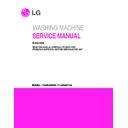LG T1828AFPH5 Service Manual ▷ View online
4-3. WIRING DIAGRAM
37
WIRING DIAGRAM
38
None
1 time
2 time
3 time
2 time
3 time
4 time
5 time
6 time
7 time
8 time
9 time
7 time
8 time
9 time
10 time
11 time
Main program version
Display program version
None
Inlet valve for bleach detergent turns
Display program version
None
Inlet valve for bleach detergent turns
on. (Cold Water)
✽
On :67~33 (26.7kHz~23.3kHz)
Inlet valve for softener dispenser turns
on. (Hot water)
Inlet valve for J-dispenser turns on.
Inlet valve for J-dispenser turns on.
(Cold Water)
Heater check (on heater model)
Wave force check
Drain pump
Agitate (pulsator) check
High speed spin
Off
Heater check (on heater model)
Wave force check
Drain pump
Agitate (pulsator) check
High speed spin
Off
. Unlocks the door
. Turns off all LED
T1 and main program version
T2 and display program version
T3
A and water level frequency (1~10 Level)
T2 and display program version
T3
A and water level frequency (1~10 Level)
✽
The meaning of 67~33 number is
26.7kHz~23.3kHz really
B and water level frequency (1~10 Level)
C and water level frequency (1~10 Level)
C and water level frequency (1~10 Level)
T4 and the coefficient of flood sensing
T5 and the coefficient of load sensing
T6 and water level frequency
T7 and the coefficient of load sensing
T8 and RPM
None
T5 and the coefficient of load sensing
T6 and water level frequency
T7 and the coefficient of load sensing
T8 and RPM
None
Number of times the
START/PAUSE
button is pressed
Check Point
Display Status
1) SAFETY CAUTION
• The main power board assembly has exposed live Rating and live DC voltages. Use care when disconnecting
connectors during troubleshooting and testing. (Wear electrostatic discharge gloves when handling the board.
• Unplug the power when handling the board assembly. (Wear electrostatic discharge gloves when handling the
board. Store the board in an ESD [ElectroStatic Discharge] plastic bag.)
2) SERVICE MODE
The washer must be empty and the controls must be plugged in and turned off.
• Press the POWER button: then press and hold the SOFT and HOT buttons. The buzzer will sound twice.
• Press the Start/Pause button to advane to the subsequent test mode step.
4-4. TEST RUNNING WITHOUT WATER
39
Many washing problems involve poor soil and stain removal, residues of lint and scum, and fabric damage. For
satisfactory washing results, follow these instructions.
Use ONLY powdered detergents. Do NOT use flakes scraped from a soap cake or bar, flakes, soap ribbons
(available in some markets,) detergent tablets, plastic pouches, magic laundry balls, or anything other than
powdered detergent products. Do not use soap of any kind. Do not use other types of detergent or soap
products, such as hand soap, dishwashng liquid, or any others.
4-5. TROUBLESHOOTING BY COMMON WASHING PROBLEMS
WASHING PROBLEM
Problems
Poor soil
removal
Blue Stains
Black or gray
marks on
clothes
Yellow or
brown rust
stains
Lint
Residue or
Detergent
Holes, tears,
or snags
Possible Causes
•
Insufficient detergent
•
Wash water temperature too low
•
Incorrect wash cycle
•
Laundry missorted
•
Stains not properly pretreated
•
Undiluted fabric softener
dispensed directly onto fabric
•
A buildup caused by the interaction
of fabric softener and detergent
can flake off and mark clothes
•
Not enough detergent
•
Iron or manganese in water
supply, water pipes, or water
heater
•
Incorrect sorting
•
Tissues left in pocket
•
Overloading the washer
•
Overloading the washer
•
Undissolved detergent
•
Excessive detergent
•
Incorrect use of chlorine bleach.
•
Unfastened zippers, hooks,
buckles
•
Ribs, tears and broken threads
•
Overloading the washer
•
Degradation of fabric
Solutions and Preventive Measures
•
Use correct amount of detergent for load size, amount of soil and
water hardness.
•
Use WARM or HOT water for normal soil. Different water
temperature may be required according to soil type. (refer to page 12)
•
Reduce load size.
•
Wash with heavy or soak & heavy wash cycle for heavy soiled
laundry.
•
Separate heavily soiled items from lightly soiled ones.
•
Pretreat stain and heavy soil according to directions shown on
page 17.
•
Pretreat the stain with detergent or a stain removal agent.
•
Do not overfill fabric softener dispenser and do not pour liquid fabric
softener directly onto fabric.
See page 15 for more instructions.
•
Keep the recommendations against scum (waxy buildup).
•
Use correct amount of detergent for load size, soil level,
and water Hardness.
•
To restore discolored load of whites, use rust remover safe for
fabric.
•
Install nonprecipitating water softener or an iron filter in your
water supply system for an ongoing problem.
•
Before washing, run water for a few minutes to clear lines.
•
Wash lint-producing items, like flannel sheets, towels, and the like
separately from dark fabrics and fabrics that tend to collect lint.
Remove all items, including tissues and papers, from the pockets of
items to be washed. See page 11 for sorting information.
•
Do not overload the washer
•
Do not overload the washer.
•
Some detergents need to be pre-dissolved, check the
detergent instructions. Try pre-dissolving the detergent.
•
Increase water temperature using HOT water safe for fabric.
•
Use proper amount of detergent.
•
Never pour chlorine bleach directly on fabric.
See page 13 for adding liquid bleach.
•
Fasten zippers, hooks, and buckles.
•
Remove objects in pockets. See page 9 for caring before loading.
•
Do not overload the washer.
4-6. TROUBLESHOOTING SUMMARY
40
Pin1: Rx Pin2:
Tx
Pin3: Smps2_5v Pin4: GN
D
Pin5: Standby Pin6: Smps2_13v Pin7: Boot
76.5 kΩ
50.6 kΩ
23.6 kΩ
16.6 kΩ
7.5 kΩ
5.6 kΩ
Click on the first or last page to see other T1828AFPH5 service manuals if exist.

